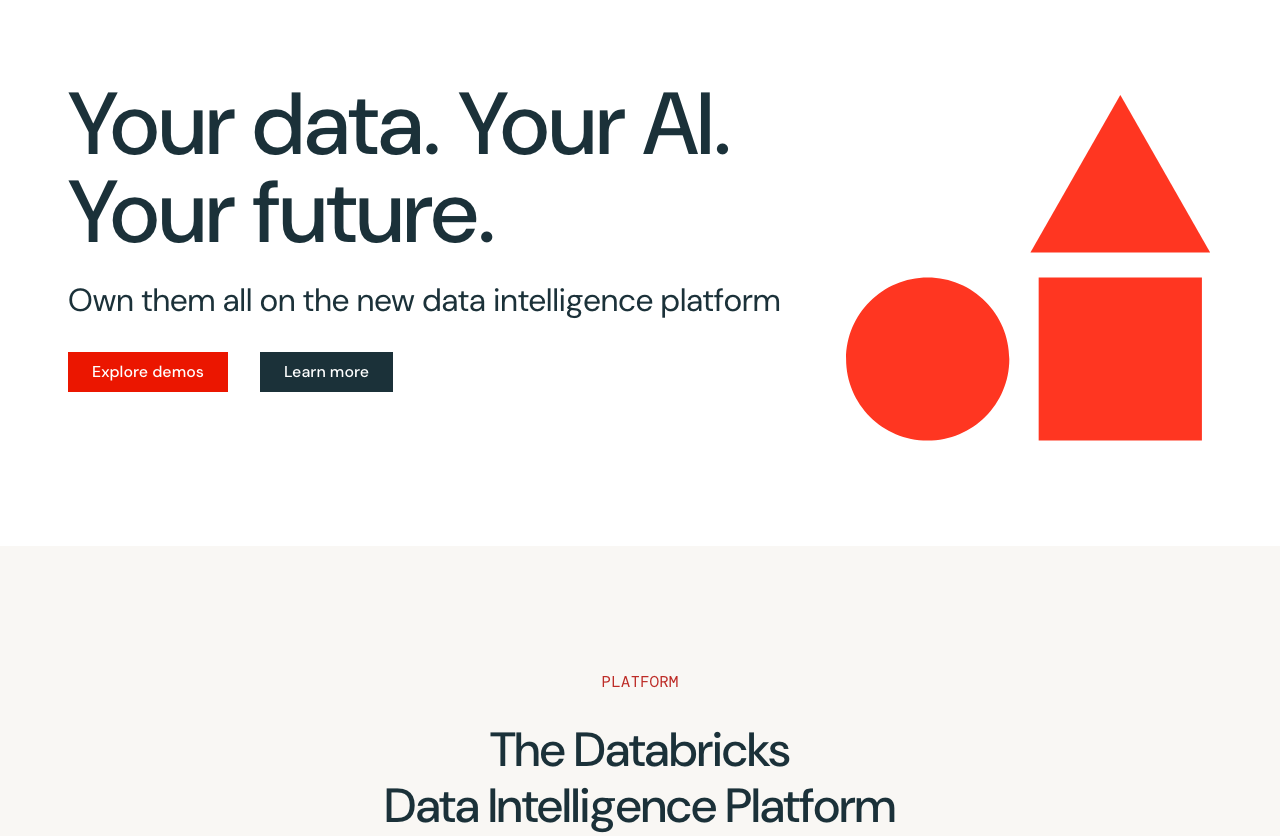
About Databricks
Rate this Tool
Share this Tool
Video Showcase
AI Agents with Databricks in 5 Minutes
Databricks is a data and AI company that provides the Data Intelligence Platform, built on an open lakehouse architecture for unified analytics, governance, and AI. Their platform democratizes data insights across organizations, enabling technical and non-technical users to discover, use, and operat

AI Agents with Databricks in 5 Minutes
Deepen your understanding of the concepts behind tools like Databricks with our expert guides.
Understand core concepts like LLMs and Machine Learning.
Master search, filtering, and comparison to find the perfect tool.
Learn to craft effective prompts to command AI models.
Integrate AI into your daily workflows ethically and effectively.
Comparing 4 AI tools.
| Feature | ||||
|---|---|---|---|---|
Upvotes | 103 | 296 | 332 | 481 |
Avg. Rating | 4.0 | 5.0 | 4.7 | 4.3 |
Slogan | The Data and AI Company | Unified AI and cloud for every enterprise: models, agents, infrastructure, and scale. | Build, automate, and scale AI-powered business solutions with the #1 enterprise platform. | AI workflow automation for technical teams |
Category | ||||
Pricing Model | Free Pay-per-Use Contact for Pricing Enterprise | Freemium Pay-per-Use Enterprise Contact for Pricing | Subscription Pay-per-Use Enterprise Contact for Pricing | Freemium Enterprise Contact for Pricing |
Pricing Details | Databricks pricing is primarily pay-per-use, metered in Databricks Units (DBUs), which vary by cloud provider, compute type, region, and product tier (Standard, Premium, Enterprise). Standard is being phased out for AWS/GCP. A free 14-day trial is offered. Significant discounts or custom pricing are available through direct sales and committed contracts ('Contact for Pricing', 'Enterprise'). No new subscription or freemium models identified as of 2025. | Free tier; Pro at $19.99/month; Ultra at $249.99/month; Vertex AI usage-based pricing; Enterprise/committed plans available via sales. | Sales Cloud Essentials $25/user/month, Professional $80, Enterprise $165, Unlimited $330, Unlimited+ $500 (all USD, per user/month); Agentforce Flex Credits pay-per-action (20 credits = $0.10/action); Slack Business+ $15/user/month; Enterprise+ plan—contact for pricing. Large deployments and advanced customizations are negotiated case-by-case. | Self-hosted Community Edition is free. Starter (Cloud) is $24/month, Pro is $60/month, Business and Enterprise are custom-priced in USD. |
Platforms | ||||
Target Audience | Software Developers, Scientists, Business Executives, Entrepreneurs | Software Developers, Scientists, Product Managers, Business Executives, Entrepreneurs, Educators, Students, Customer Service, Healthcare Providers | Software Developers, Marketing Professionals, Business Executives, Entrepreneurs, Product Managers, Customer Service | Software Developers, Product Managers, Business Executives, Entrepreneurs, Marketing Professionals, AI Enthusiasts |
Website |
List it FREE and compete alongside the tools above
Free Listing: Showcase your AI solution to thousands of professionals searching for the right tool.
No credit card required. Start gaining visibility today! ✨
Use this page as a starting point to evaluate Databricks alongside similar options. Our directory focuses on practical details that matter for adoption—capabilities, pricing signals, integrations, and real audiences—so you can shortlist with confidence and move from exploration to evaluation faster.
For a structured head‑to‑head, try the comparison view: Compare AI tools. To stay current with launches, model updates, and research breakthroughs, visit AI News. New to the space? Sharpen your understanding with AI Fundamentals.
Before adopting any tool, model your total cost at expected usage, verify integration coverage and API quality, and review privacy, security, and compliance. A short pilot on a real workflow will reveal reliability and fit quickly. Bookmark this site to track updates to Databricks and the broader ecosystem over time.
Take your tool to the next level with Featured placements, Academy mentions with high-authority backlinks, 48h Fast‑Track listing, Newsletter features to thousands of AI practitioners, and exclusive Data/API access for growth insights.
No reviews yet
Be the first to review this tool!
Rating Distribution
Share your experience with Databricks by creating an account
No reviews yet. Be the first to share your experience!
Databricks offers a no-cost plan so you can explore across Web App, Desktop App, and Mobile App. Validate real workflows before you lock in budget or long-term contracts. Integrations with Plugin/Integration keep work connected.
Multi-platform support ensures everyone can use Databricks regardless of their device preference. Available across Web App, Desktop App, and Mobile App for consistent adoption.
Rate limits and authentication are clearly documented for smooth implementation. Automation handles the repetitive work so teams can focus on strategy.
SDKs (e.g., Python, JVM (Java/Kotlin/Scala), and .NET (C#)) help dev teams launch prototypes quickly.
Trigger-based flows keep work moving without extra check-ins. Automation handles the repetitive work so teams can focus on strategy.
Dashboards and analytics surface the metrics teams need to act. Analytics and reporting surface the metrics needed to act quickly.
With SDKs and webhooks, engineers connect Databricks to deployments, CI/CD, and monitoring pipelines. Automation handles the repetitive work so teams can focus on strategy.
Operations teams rely on Databricks to orchestrate tasks across departments. Automation handles the repetitive work so teams can focus on strategy.
Stakeholders can answer ad hoc questions without waiting on a manual request queue. Analytics and reporting surface the metrics needed to act quickly.
Databricks pricing is primarily pay-per-use, metered in Databricks Units (DBUs), which vary by cloud provider, compute type, region, and product tier (Standard, Premium, Enterprise). Standard is being phased out for AWS/GCP. A free 14-day trial is offered. Significant discounts or custom pricing are available through direct sales and committed contracts ('Contact for Pricing', 'Enterprise'). No new subscription or freemium models identified as of 2025.
Usage Model: Credits, Pay-as-You-Go, Storage — ensuring you only pay for what you actually use.
Discover more AI tools in related categories, platforms, and use cases.


AI is revolutionizing industries, and selecting the right tools is crucial for business success. Discover top-rated AI solutions to enhance customer service, automate marketing, and streamline operations. Prioritize user satisfaction…
